sequenceDiagram participant Alice participant Bank Alice->>Bank: Hello Bank, here is my eKYC zip file? Bank->>Alice: What's the four digit code? Alice->>Bank: It is 0076 Note right of Bank: Unzips file and checks RSA signature.<br/> Checks photo matches Alice's appearance Bank->>Alice: What's your mobile number? Alice->>Bank: It is 9833456789 Note right of Bank: Calculates hash of number and<br/> checks equality with hash <br/> in document Bank->>Alice: What's your email address? Alice->>Bank: It is alice@gmail.com Note right of Bank: Calculates hash of email and<br/> checks equality with hash <br/> in document Bank->>Alice: Your eKYC is done!
Faster Food Deliveries using ZK Proofs
October 4, 2023
The Problem
Food delivery agents stop at the IITB main gate to enter name and phone number
- Food gets cold 😠
Why not have the data on a QR code?
- No guarantees about the correctness of the data
What if a trusted party verified the data and signed it?
- The Aadhaar infrastructure (almost) does what we want
The Aadhaar Offline eKYC document is a digitally signed document containing the card holder’s details
Getting the Offline eKYC Document
Login to myAadhaar
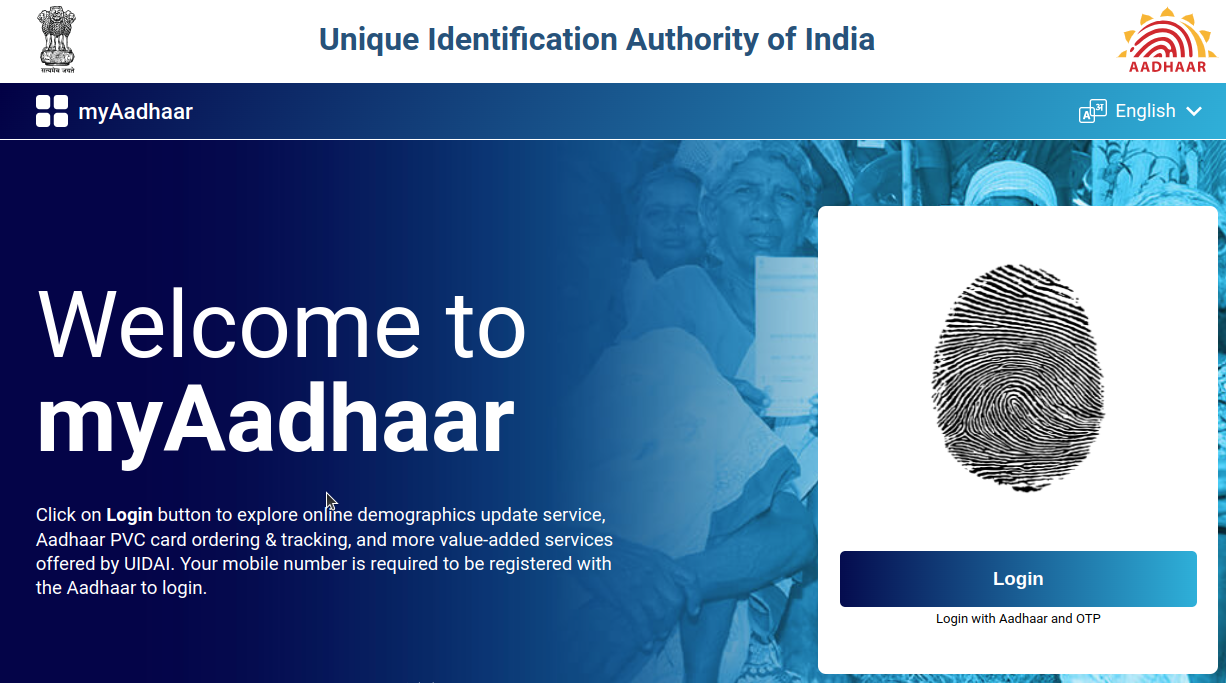
Find Offline eKYC Download Link
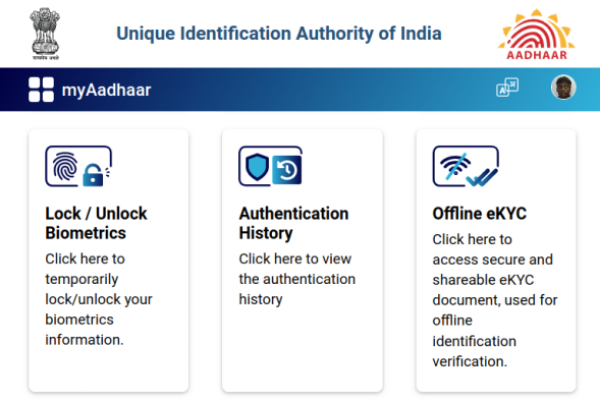
Set 4-Digit PIN
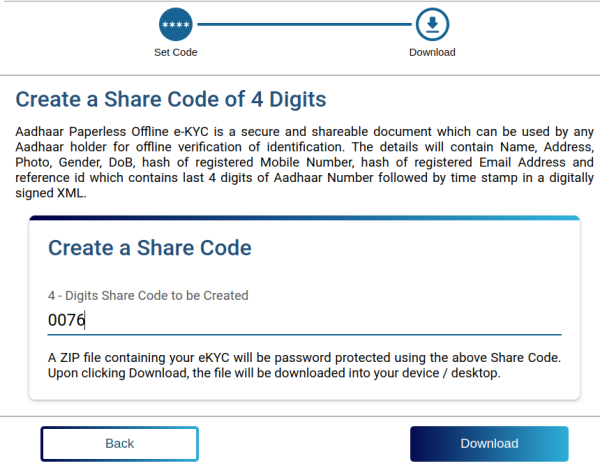
Success Screen
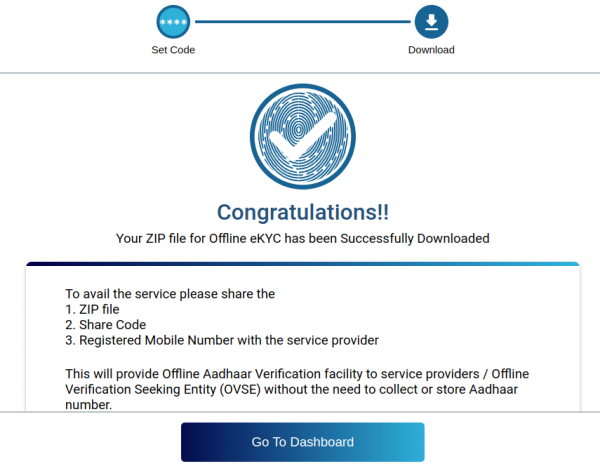
Cryptographic Hash Functions
- Methods for deterministically mapping a long input string to a shorter output called a digest
- Primary requirement is that it should be infeasible to find collisions, i.e. two distinct inputs having same digest
Non-Cryptographic Hash Functions
Used to build hash tables — key-value stores with faster lookup time
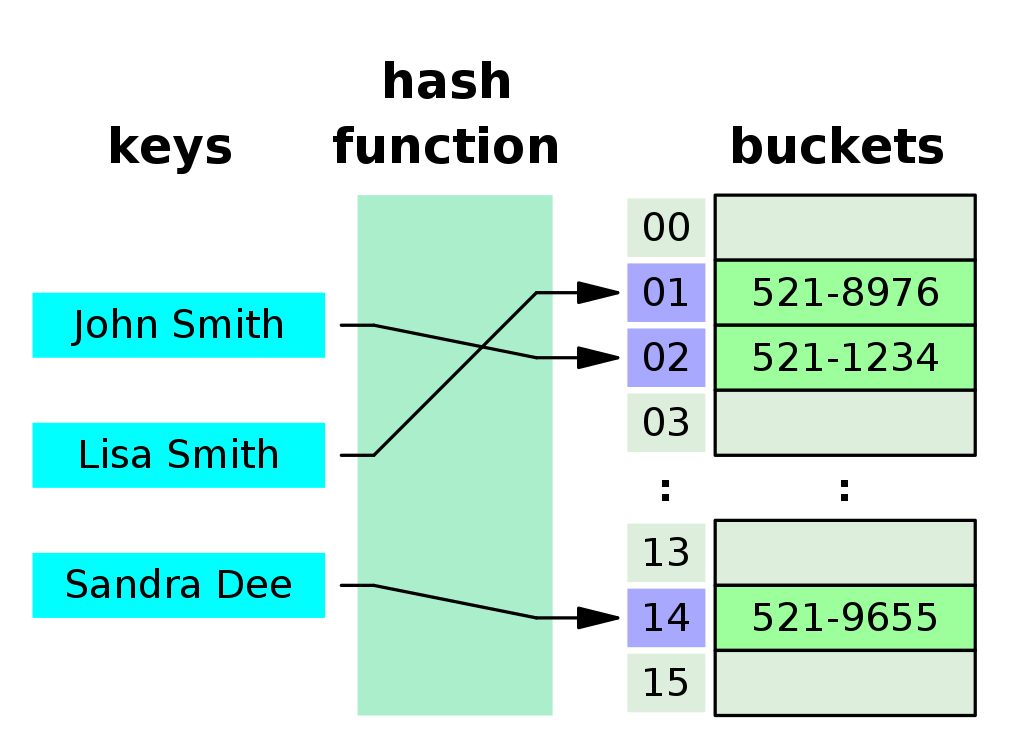
Image credit: Jorge Stolfi
Handling Collisions in Hash Tables
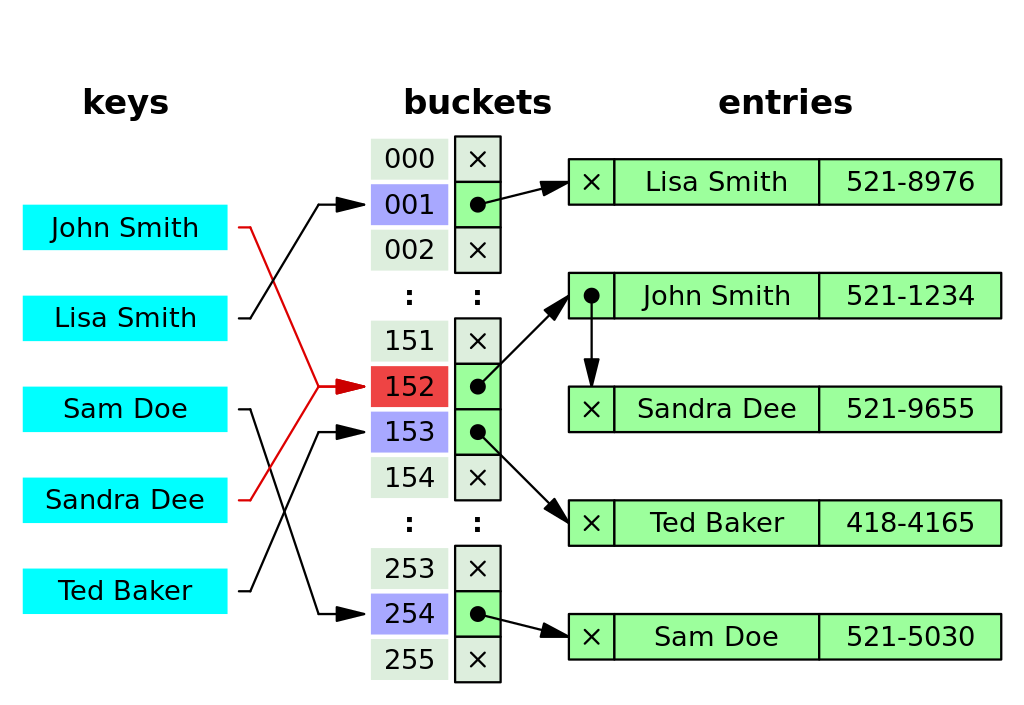
Image credit: Jorge Stolfi
Collision Avoidance
- A collision is said to occur if \(h(x) = h(x')\) for \(x \neq x'\)
- For non-cryptographic hash functions, the goal is to minimize collisions
- For cryptographic hash functions, the goal is to completely avoid collisions
- Achieved by defining a large co-domain for \(h\)
Co-Domain for 256-bit Output Length
SHA-256
- SHA = Secure Hash Algorithm, 256-bit output length
- Accepts bit strings of length upto \(2^{64}-1\)
- Announced in 2001 by NIST
Two Stages
- Output calculation has two stages
- Preprocessing
- Hash Computation
Preprocessing
- The input \(M\) is padded to a multiple of 512 bits
- A 256-bit state variable \(H^{(0)}\) is set to \[\begin{align*} \begin{split} H_0^{(0)} = \texttt{0x6A09E667},& \quad H_1^{(0)} = \texttt{0xBB67AE85},\\ H_2^{(0)} = \texttt{0x3C6EF372},& \quad H_3^{(0)} = \texttt{0xA54FF53A},\\ H_4^{(0)} = \texttt{0x510E527F},& \quad H_5^{(0)} = \texttt{0x9B05688C},\\ H_6^{(0)} = \texttt{0x1F83D9AB},& \quad H_7^{(0)} = \texttt{0x5BE0CD19}. \end{split} \end{align*}\]
- First 32 bits in the fractional parts of the square roots of the first eight primes
- NUMS = Nothing Up My Sleeve
Hash Computation
A function \(f: \{0,1\}^{512} \times \{0,1\}^{256} \rightarrow \{0,1\}^{256}\) is used. It is called the compression function
Padded input is split into 512-bit blocks \(M^{(1)}, \ldots, M^{(N)}\)
Given \(H^{(i-1)}\), the next \(H^{(i)}\) is calculated as \[\begin{equation*} H^{(i)} = f(M^{(i)}, H^{(i-1)}), \quad 1 \le i \le N. \end{equation*}\]
\(H^{(N)}\) is the output of SHA-256 for input \(M\)
Building Blocks of \(f\)
- \(U\), \(V\), \(W\) are 32-bit words
- \(U \land V, U \lor V\), \(U \oplus V\) denote bitwise AND, OR, XOR
- \(U + V\) denotes integer sum modulo \(2^{32}\)
- \(\lnot U\) denotes bitwise complement
- For \(1 \le n \le 32\), the shift right and rotate right operations \[\begin{align*} \textsf{SHR}^n(U) & = \underbrace{000 \cdots 000}_{n \textrm{ zeros}} u_0 u_1 \cdots u_{30-n} u_{31-n}, \\ \textsf{ROTR}^n(U) & = u_{31-n+1} u_{31-n+2} \cdots u_{30} u_{31} u_0 u_1 \cdots u_{30-n} u_{31-n}, \end{align*}\]
Building Blocks of \(f\)
- Bitwise choice and majority functions \[\begin{align*} \textsf{Ch}(U,V,W) & = (U \land V) \oplus (\lnot U \land W), \\ \textsf{Maj}(U,V,W) & = (U \land V) \oplus (U \land W) \oplus (V \land W), \end{align*}\]
- Let \[\begin{align*} \Sigma_0(U) & = \textsf{ROTR}^{2}(U) \oplus \textsf{ROTR}^{13}(U) \oplus \textsf{ROTR}^{22}(U) \\ \Sigma_1(U) & = \textsf{ROTR}^{6}(U) \oplus \textsf{ROTR}^{11}(U) \oplus \textsf{ROTR}^{25}(U) \\ \sigma_0(U) & = \textsf{ROTR}^{7}(U) \oplus \textsf{ROTR}^{18}(U) \oplus \textsf{SHR}^{3}(U) \\ \sigma_1(U) & = \textsf{ROTR}^{17}(U) \oplus \textsf{ROTR}^{19}(U) \oplus \textsf{SHR}^{10}(U) \end{align*}\]
\(f\) Calculation
- Maintains internal state of 64 words \[\{W_j \mid j = 0,1,\ldots,63\}\]
- Uses 64 constant words \(K_0, K_1, \ldots, K_{63}\) derived from the first 64 primes
- \(f(M^{(i)}, H^{(i-1)})\) proceeds as follows
- Internal state initialization \[\begin{equation*} W_j = \begin{cases} M_j^{(i)} & 0 \le j \le 15, \\ \sigma_1(W_{j-2}) + W_{j-7} + \sigma_0(W_{j-15}) + W_{j-16} & 16 \le j \le 63. \end{cases} \end{equation*}\]
- Initialize eight 32-bit words \[\begin{equation*} (A,B,C,D,E,F,G,H) = \left(H_0^{(i-1)}, H_1^{(i-1)}, \ldots, H_6^{(i-1)}, H_7^{(i-1)}\right). \end{equation*}\]
- For \(j = 0,1,\ldots,63\), iteratively update \(A,B,\ldots,H\) \[\begin{align*} \begin{split} & T_1 = H + \Sigma_1(E) + \textsf{Ch}(E,F,G) + K_j + W_j \\ & T_2 = \Sigma_0(A) + \textsf{Maj}(A,B,C) \\ & (A,B,C,D,E,F,G,H) = (T_1+T_2, A, B, C, D+T_1, E, F, G) \end{split} \end{align*}\]
- Calculate \(H^{(i)}\) from \(H^{(i-1)}\) \[\begin{equation*} (H_0^{(i)}, H_1^{(i)}, \ldots, H_7^{(i)}) = \left(A+H_0^{(i-1)}, B+H_1^{(i-1)}, \ldots, H+H_7^{(i-1)}\right). \end{equation*}\]
Observations
- SHA-256 is complicated but can be computed easily
- Difficult to invert
- Difficult to find collisions
Applications of Hash Functions
Password hashing
- Servers store hashes of passwords instead of actual passwords
Commitment Schemes
- To commit to a secret \(x\), publish \(H(\textsf{salt} \| x)\)
- To prove commitment to \(x\), reveal \(\textsf{salt}\)
Structure of the Offline eKYC Document
XML Format
<?xml version="1.0" encoding="UTF-8"?>
<note>
<to>eeseminar</to>
<from>Sibi</from>
<heading>Reminder</heading>
<body>We have a colloquium today. Please attend!</body>
</note>XML = eXtensible Markup Language
Textual data format for representing arbitrary data
Base64
Binary-to-text encoding used to represent some fields in the XML file
Divides a byte sequence into groups of 3 bytes (24 bits)
- Adds padding if necessary
Divides a 24 bit chunk into four 6 bit chunks
Maps each 6 bit chunk to a character from
ABCDE...XYZabcde...xyz0123456789+/
Contents of Offline eKYC Document
<?xml version="1.0" encoding="UTF-8"?>
<OfflinePaperlessKyc referenceId="372520231003155749167">
<UidData>
<Poi dob="DD-MM-YYYY"
e="558d55fe5740c50058...518b702521b1448a6509ccb"
gender="M"
m="328f6d1c0adad4ad4...cf3589b98c617aa1d45afcf2"
name="Saravanan Vijayakumaran"
/>
<Poa careof="S/O XXXXXXXXXXXXX XXXXXXXXX"
country="India"
dist="Mumbai"
house="EE122B, Dept of Electrical Engineering"
landmark=""
loc="Powai"
pc="400076"
po="Powai IIT"
state="Maharashtra"
street="I.I.T.Bombay"
subdist="Mumbai"
vtc="Mumbai"
/>
<Pht> ..snip.. </Pht>
</UidData>
<Signature xmlns="http://www.w3.org/2000/09/xmldsig#">
<SignedInfo>
<CanonicalizationMethod Algorithm="<snip>"/>
<SignatureMethod Algorithm="<snip>#rsa-sha1"/>
<Reference URI="">
<Transforms>
<Transform Algorithm="<snip>"/>
</Transforms>
<DigestMethod Algorithm="<snip>#sha256"/>
<DigestValue>rtb44DBF...TVVmMDWLZriVY=</DigestValue>
</Reference>
</SignedInfo>
<SignatureValue>
<snip>
</SignatureValue>
<KeyInfo>
<snip>
</KeyInfo>
</Signature>
</OfflinePaperlessKyc>- 1
- XML version
- 2
- 4 digits of Aadhaar + timestamp
- 3
- Start of user data
- 4
-
dobis the date of birth - 5
- Hash of email address
- 6
- Hash of phone number
- 7
- Photo encoded in base64 format
- 8
- End of user data
- 9
- Start of signature data
- 10
- Start of data that is signed
- 11
- Signature method is RSA-SHA1
- 12
- Message digest generation method is SHA256
- 13
- SHA256 hash of user data in base64 format
- 14
- RSA signature verifiable by Aadhaar public key
- 15
- Info about Aadhaar public key
- 16
- End of signature data
Offline eKYC Document Generation
Hashes of user email/mobile number are generated and inserted into the rest of the user data
The user data is hashed using SHA256
The SHA256 hash is inserted into the following XML block
The
SignedInfoblock is hashed with SHA1 and signed with Aadhaar’s private keyAny change to the user data will invalidate the signature
Offline eKYC Workflow
Back to Faster Food Deliveries
Desired Workflow
sequenceDiagram participant Agent as Delivery Agent participant Guard as IITB Security Agent->>Guard: Hello, here is SHA256 hash of my details? Guard->>Agent: Give me the RSA signature that <br/> authenticates this hash? Agent->>Guard: Here it is. Note right of Guard: Checks RSA signature Guard->>Agent: What's your name and mobile number? Agent->>Guard: Alice, 9833456789 Guard->>Agent: Give me a proof that these are in the <br/> SHA256 hash you shared earlier Agent->>Guard: Here it is. Note right of Guard: Verifies the proof Guard->>Agent: You can enter campus.
How to generate the proof?
We want to prove that the name and phone number are contained in the preimage of a SHA256 hash
- Without revealing the other bytes in the preimage
Zero-Knowledge Proofs
- Cryptographic techniques for proving a statement without revealing nothing else
SNARK = Succinct Non-interactive Arguments of Knowledge
- Enables verifiable computation
zkSNARK = Zero-Knowledge SNARK
- Additionally, enables privacy
Statement Representation
To prove statements using zkSNARKs, they need to be expressed as arithmetic circuits
- Circuit variables are prime field elements
- Only addition and multiplication are allowed
Prime fields
- \(\mathbb{F}_p = \{0,1,\ldots,p-1\}\) where \(p\) is a prime
- Arithmetic modulo \(p\)
Arithmetic Circuit Example
flowchart LR a[a] --> plus1(+) b[b] --> plus1 c[c] --> mul1(*) d[d] --> mul1 plus1 --> plus2(+) mul1 --> plus2 plus2 --> e[e] a --> mul2(*) e[e] --> mul2 mul2 --> f[f]
Rank-1 Constraint Systems
Statement is represented using quadratic constraints of the form \[\begin{align*} \left(a_0 + \sum_{i=1}^n a_i w_i \right) \cdot \left(b_0 + \sum_{i=1}^n b_i w_i\right) = \left( c_0 + \sum_{i=1}^n c_i w_i\right) \end{align*}\]
The \(a_i, b_i, c_i\) values are determined by the statement
The \(w_i\)’s are witness values specific to the instance
Rank 1?
\[\begin{align*} & \left(a_0 + \sum_{i=1}^n a_i w_i \right) \cdot \left(b_0 + \sum_{i=1}^n b_i w_i\right) \\ = & \langle \textbf{a}, (1,\textbf{w}) \rangle \cdot \langle \textbf{b}, (1,\textbf{w}) \rangle \\ = & \begin{bmatrix} 1 & \textbf{w} \end{bmatrix} \underbrace{\begin{bmatrix} a_0 \\ a_1 \\ \vdots \\ a_n \end{bmatrix} \begin{bmatrix} b_0 & b_1 & \cdots & b_n \end{bmatrix}}_{A} \begin{bmatrix} 1 \\ \textbf{w}^T \end{bmatrix} \end{align*}\]R1CS for SHA256
SHA256 has operations like
- Bitwise AND, OR, XOR, complement
- Choice function
- Integer sum mod \(2^{32}\)
- Shift right and rotate right
How can these be represented in a R1CS?
R1CS Gadgets for SHA256
AND and OR Gates
If \(a \in \mathbb{F}_p = \{0,1,\ldots,p-1\}\) satisfies \(a(1-a) = 0\), then \(a \in \{0,1\}\)
Given \(a(1-a) = 0, b(1-b) = 0\)
- \(c = a \land b\) is expressed as \[ab = c\]
- \(c = a \lor b\) is expressed as \[(1-a)\cdot(1-b) =1- c\]
XOR Gate
Given \(a(1-a) = 0, b(1-b) = 0\), we can express \(c = a \oplus b\) as \[(a+a) \cdot b = a + b - c.\]
If \(b=0\), then \(c = a\)
If \(b=1\), then \(c = 1-a\)
Addition Modulo \(2^{32}\)
A 32-bit word = Vector of 32 booleans
- \(U = [U_0, U_1, \ldots, U_{31}]\)
- Costs 32 constraints of the form \(x(1-x) = 0\)
To get \(W = U +V \bmod 2^{32}\)
- Calculate field element \(u = \sum_{i=0}^{31} U_i \cdot 2^i\)
- Calculate field element \(v = \sum_{i=0}^{31} V_i \cdot 2^i\)
- Allocate 33 bits \(W = [W_0, W_1,\ldots,W_{32}]\)
- Calculate field element \(w = \sum_{i=0}^{32} W_i \cdot 2^i\)
- Check that \(w = u+v\)
- Truncate \(W\) to 32 bits
Selective Disclosure of SHA256 Preimages
Selective Disclosure of SHA256 Preimages
Agent will reveal two SHA256 hashes \(h_1\), \(h_2\)
The first hash \(h_1\) has been signed by Aadhaar system
Agent will prove knowledge of message \(\vec{m} \in \{0,1\}^n\) and mask vector \(\vec{v} \in \{0,1\}^n\) such that \[\begin{align*} & \text{SHA256}(\vec{m}) = h_1, \\ & \text{SHA256}(\vec{m} \circ \vec{v}) = h_2. \\ \end{align*}\]
Agent will reveal \(\vec{m} \circ \vec{v}\)
Guard can verify that the hash of \(\vec{m} \circ \vec{v}\) matches \(h_2\)
Proof Generation Time
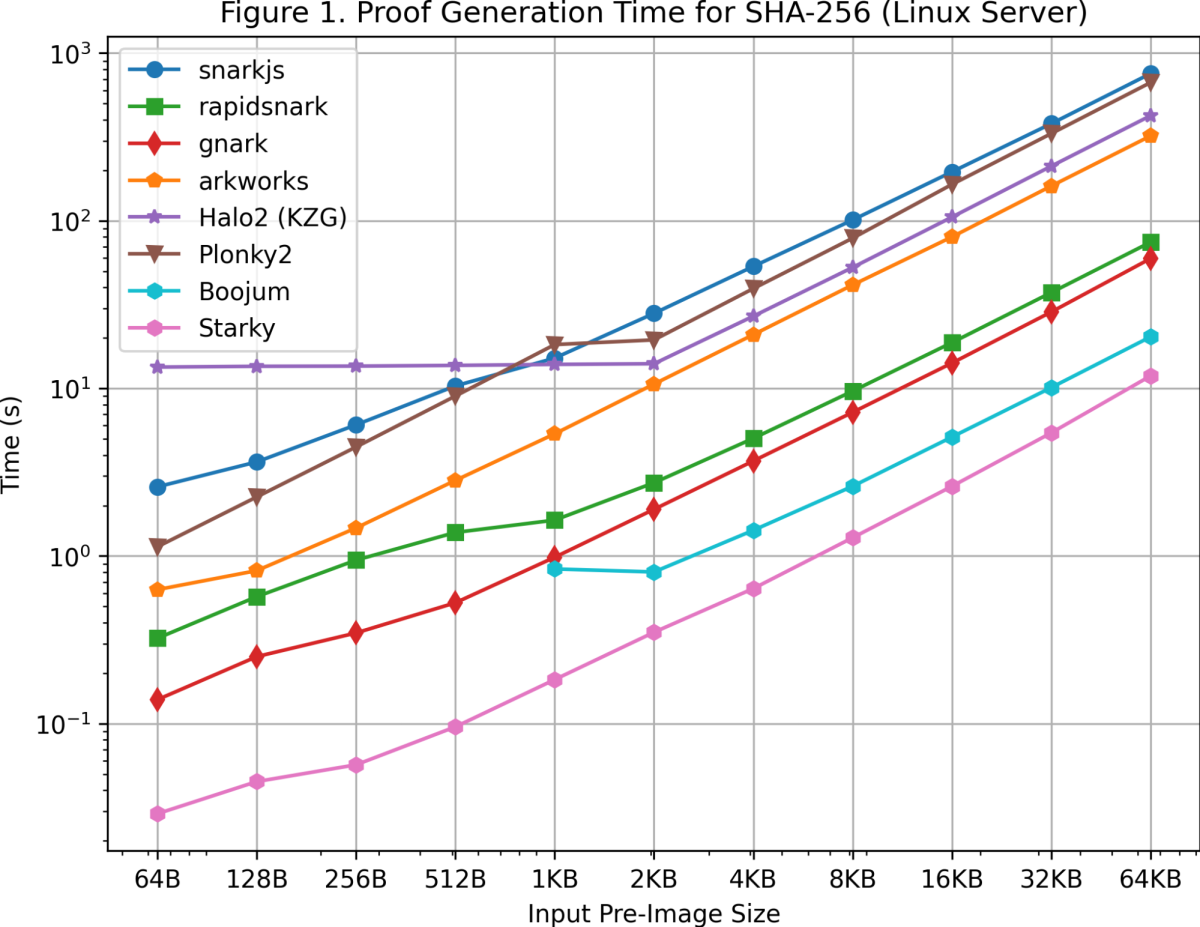
Image credit: Celer Network Benchmarks
Prover Memory Requirement
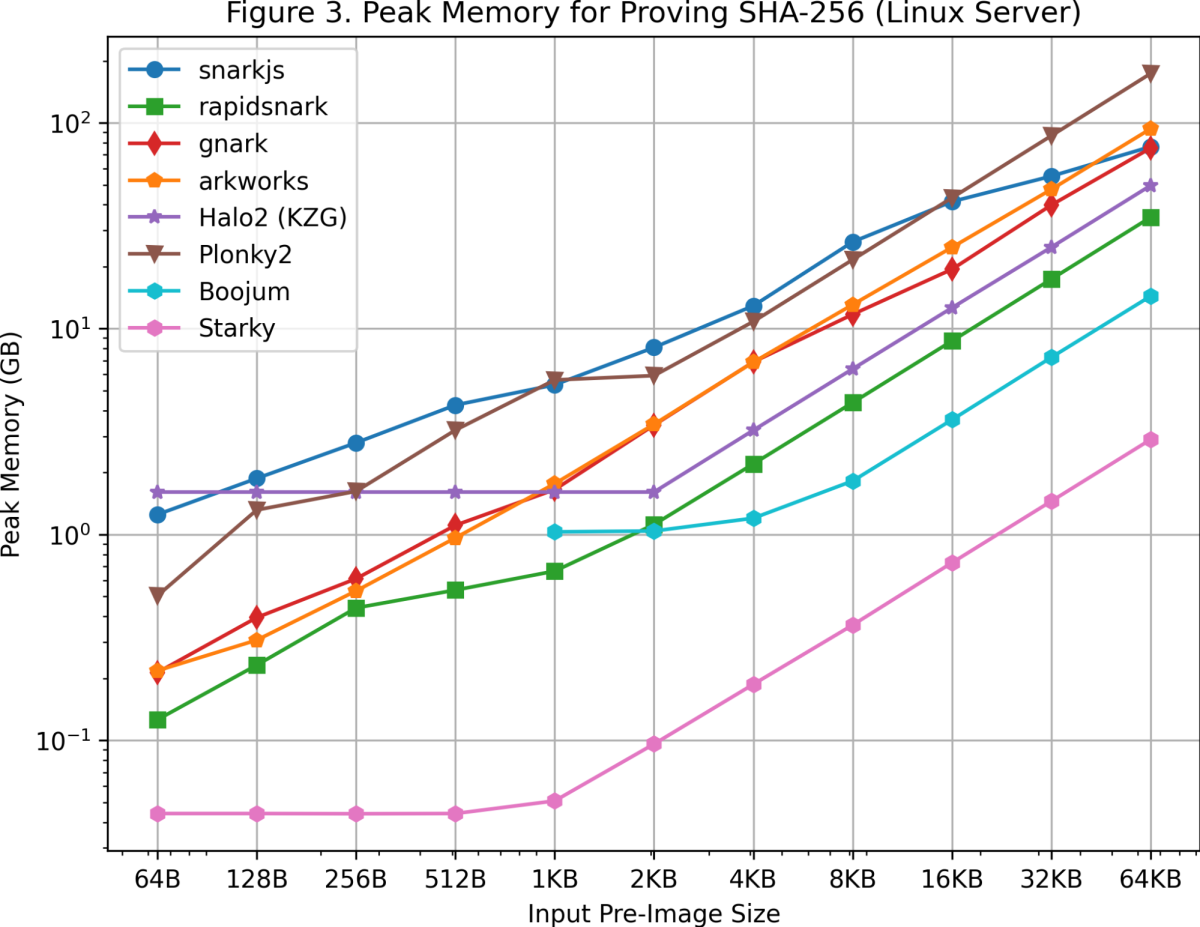
Image credit: Celer Network Benchmarks
Nova
A recursive SNARK for incremental verifiable computation
Allows a prover to prove that for some function \(F\) and public values \(z_0\) and \(z_n\), it knows private \(w_{i}\)’s such that \[z_n = F \left( \ldots F \left(F \left(F \left( z_0, w_0 \right), w_1 \right),w_2\right), \ldots,w_{n-1}\right).\]
Nova is a folding scheme which folds all the R1CS steps into a single relaxed R1CS instance
- The number of constraints in the latter is proportional to the number of constraints in a single step
Selective Disclosure of SHA256 Preimages using Nova
SHA256 hash computation has an iterative structure
Our Nova step function \(F\) is specified as follows
- Private inputs are message and mask blocks
- Public outputs are digests of message and masked message
- Number of steps is \(N\)
Demo
Resources
- Aadhaar eKYC Documentation https://uidai.gov.in/en/ecosystem/authentication-devices-documents/about-aadhaar-paperless-offline-e-kyc.html
- Nova reference implementation https://github.com/microsoft/Nova
- Nova-SHA256 repo https://github.com/avras/nova-sha256
- Celer Network Benchmarks https://blog.celer.network/
- Nova-Aadhaar repo (coming soon..)